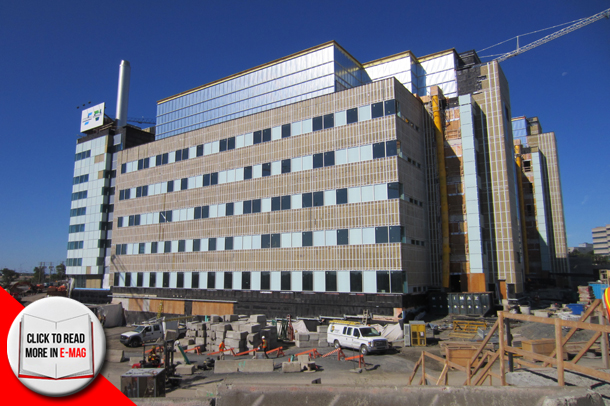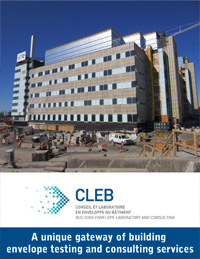A unique gateway of building envelope testing and consulting services
By: Cheryl Long
Sister companies Air-Ins Inc. and Patenaude Trempe Van Dalen Inc. (PTVD) are not new names in the field of building science, but their decision to rebrand this year under the group name CLEB is one way the company continues its commitment to innovation.
The name itself is unique. CLEB stands for Conseil et laboratoire en envelope du bâtiment or, when reading the acronym backwards in English, Building Envelope Laboratory and Consulting. Strategically repositioning Air-Ins and PTVD under one brand will create a dynamic group synergy, and their new trademark, CLEB, will eventually be as recognizable as the two names that came together to form one of the strongest partnerships in the building envelope sector. “We basically developed this new image so everyone understands we’re from the same group,” company President Mario Goncalves explained. “…eventually those names may or may not disappear. We’re marketing our company as a group, a one-stop shop basically.”
The group has a strong reputation built on years of experience and knowledge, and a solid client base throughout eastern Canada and the northeastern United States. PTVD represents the consulting end of the business, providing a range of services that includes quality control services relating to design assistance, onsite testing, and commissioning, as well as the investigation of building envelope failures on existing buildings. Their role as building envelope consultants is a crucial one: to guide and advise their clients on the importance of quality and durability in the design of their building’s outer shell, and how that structure can be impacted by critical elements. Air-Ins takes the science to the next level by having the group’s independent testing laboratory specialize in the performance evaluation of the building envelope’s components. By conducting prototype tests, the lab can gauge whether the components meet performance levels set by the project specifications. Airtightness, watertightness and structural performance are all key testing areas, along with thermal performance and resistance to condensation. Essentially, CLEB can be involved in the process from start to finish.
“During construction we’re there for quality control; to make sure it’s built right,” Goncalves said. “We test the building during construction and we test parts of the building in the lab before it gets built.”
Along with new construction, CLEB is also called in to work on existing buildings. They’ll investigate any issues on the outer shells, whether it’s water leakage and provide recommendations for repair. As consultants, they will assist the architects to ensure the design has been implemented correctly through on-site inspections and testing, providing the building’s owner with “peace of mind that somebody is looking after their interests … that this thing is built properly and doesn’t have any issues and not get sued.”
At the root of CLEB’s reputation is a strict adherence to building codes and standards. Air-Ins is accredited by several organizations, including the Standards Council of Canada (SCC), the Canadian Standards Association (CSA), the American Architectural Manufacturers Association (AAMA) and the National Fenestration Rating Council (NFRC), Florida Building Code and is recognized by the Canadian Construction Materials Centre (CCMC). CLEB plays a role on several standards committees and actively participates in the development of new codes and standards, often serving as one of the first companies to implement the new rules.
Window, door and curtain-wall manufacturers are Air-Ins’ most prolific clients, not surprisingly since those components make up the majority of the building envelope. “We’ll test to make sure it resists water penetration, resists air leakage, for condensation and thermal performance in terms of R-value,” Goncalves said. It’s not unlike new car buyers who test drive a number of vehicles before settling on a particular model. “If you want to buy a new window and you’re an informed consumer, you’ll compare five or six products and you’ll compare the same performance criteria. You compare different ratings and products and make a smart decision in terms of what you’re getting for your money.”
Testing is also conducted on a much larger scale. Inside the Air-Ins lab, it’s not uncommon to find two-storey prototypes of an exterior wall, complete with samples of all of the future building’s components. Small and large windows, balconies, brick and glass can all be included in the prototype version, ready to undergo rigorous testing.
“We’ll build it and we’ll test it and we’ll verify that no water can get in and the air doesn’t get out and you don’t have any ice forming, and nothing falls apart,” Goncalves explained. “We’ll take that assembly and if there’s something that doesn’t work in the lab, we’ll change it and modify it until it works and then the Contractor will build it on site based on what we learned in the lab.”
If the thought of a two-storey prototype is fascinating to visitors, it draws just as much interest from the company’s own employees. Part of CLEB’s recent rebranding included the construction of a new head office in Varennes, just a short distance from downtown Montreal. The building houses both the office and laboratory facilities, which means that employees from the consulting end can visit the testing areas and profit from the wealth of ongoing activities. It’s a culture of collaboration and education, made even more inviting by amenities that create an appealing work environment, including an enclosed courtyard, large cafeteria with rest area, open concept offices flooded with natural light and a multi-media-equipped lounge. Two additional offices are located in Quebec City and Ottawa, and the company has also launched a new web site at www.cleb.com.
“We actually got the employees involved (in the building’s planning), getting their feedback and comments and we pretty much built our head office around our employees and our clients as well,” Goncalves said. “We create an environment where there’s always something happening and the employees are really happy. They’re very motivated by the fact that this environment is very stimulating.”
The word employee is a bit of a misnomer at CLEB. Instead, the company’s roster includes 15 business partners who all take a personal interest in how the organization performs. From architects to technologists to engineers, they’re the secret behind the company’s success, supported by additional team members who bring the working contingent to over 70. “That’s something that’s been very rewarding for the company … to be able to attract and keep some very highly qualified and reputable people in the industry because they’re business partners,” Goncalves said. “I think it’s a big thing, for potential employees coming to meet us and seeing how we’re set up. It’s very positive in terms of attracting good people.”
“We’re looking for people who fit the culture of the company and sometimes we’ll choose someone who fits the culture over someone who is more qualified.”
Goncalves has been a part of the company since 1990, shortly after the consulting group was founded by Armand Patenaude. A professional engineer and senior building envelope consultant, he arrived at the company with a diploma in architectural technology and then returned to school to earn his certificate degree in construction management in 1993, the same year he became a partner in the company. Juggling his work at PTVD and continuing education, Goncalves completed a bachelor’s degree in construction engineering in 1996 and then became president of the company in 2001.
Under Goncalves’ direction, the company continues to prosper with several new projects currently underway. CLEB is currently working on two mega-hospital projects in Montreal, three high-rise condominium developments and a Deloitte high-rise office building tower in downtown Montreal, and several ongoing commercial and construction projects. They recently won a contract to inspect all of the buildings that belong to the Quebec City hospital network and they’re the primary consultants for a major glass replacement project at the National Gallery of Canada in Ottawa.
By always looking five to 10 years into the future, CLEB is confident that their organization will remain at the industry’s helm. They look at the problems facing the industry today and how they can be avoided in the future, and are determined to remain leaders in the field by offering a range of expertise, service and industry know-how under one umbrella.
“We’re there for the industry, we’re there for the long run and we’re here to be the leaders and to be ahead of the game in our industry,” Goncalves said.







